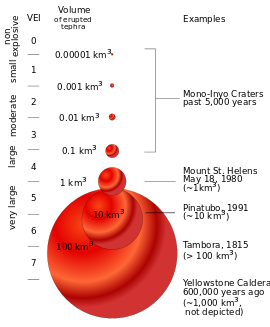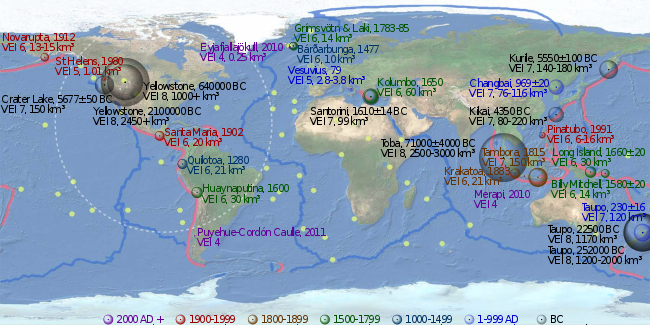


The volcanic explosivity index (VEI) is a relative measure of the explosiveness of volcanic eruptions. It was devised by Christopher G. Newhall of the United States Geological Survey and Stephen Self in 1982.
Volume of products, eruption cloud height, and qualitative observations (using terms ranging from "gentle" to "mega-colossal") are used to determine the explosivity value. The scale is open-ended with the largest eruptions in history given a magnitude of 8. A value of 0 is given for non-explosive eruptions, defined as less than 10,000 m3 (350,000 cu ft) of tephra ejected; and 8 representing a mega-colossal explosive eruption that can eject 1.0×1012 m3 (240 cubic miles) of tephra and have a cloud column height of over 20 km (66,000 ft). The scale is logarithmic, with each interval on the scale representing a tenfold increase in observed ejecta criteria, with the exception of between VEI-0, VEI-1 and VEI-2.[1]
With indices running from 0 to 8, the VEI associated with an eruption is dependent on how much volcanic material is thrown out, to what height, and how long the eruption lasts. The scale is logarithmic from VEI-2 and up; an increase of 1 index indicates an eruption that is 10 times as powerful. As such, there is a discontinuity in the definition of the VEI between indices 1 and 2. The lower border of the volume of ejecta jumps by a factor of one hundred, from 10,000 to 1,000,000 m3 (350,000 to 35,310,000 cu ft), while the factor is ten between all higher indices. In the following table, the frequency of each VEI indicates the approximate frequency of new eruptions of that VEI or higher.
| VEI | Ejecta volume (bulk) |
Classification | Description | Plume | Periodicity | Tropospheric injection |
Stratospheric injection[2] |
|---|---|---|---|---|---|---|---|
| Examples | |||||||
| 0 | < 104m3 | Hawaiian | Effusive | < 100 m | constant | negligible | none |
| Kīlauea (current), Mawson Peak (current), Dallol (2011), Holuhraun (2014-2015), Fagradalsfjall (2021-2023), Mauna Loa (1975, 1984, 2022) | |||||||
| 1 | > 104m3 | Hawaiian / Strombolian | Gentle | 100 m – 1 km | daily | minor | none |
| Yakedake (1995), Raoul Island (2006), Havre Seamount (2012), Dieng Volcanic Complex (1964, 1979, 2017), Nyiragongo (1977, 2002, 2021) | |||||||
| 2 | > 106m3 | Strombolian / Vulcanian | Explosive | 1–5 km | 2 weeks | moderate | none |
| Stromboli (since 1934), Etna (current), Unzen (1792), Ruang (1871), Ritter Island (1888), Galeras (1993), Whakaari / White Island (2019) | |||||||
| 3 | > 107m3 | Strombolian / Vulcanian / Peléan / Sub-Plinian | Severe | 3–15 km | 3 months | substantial | possible |
| Surtsey (1963-1967), Nevado del Ruiz (1985), Redoubt (1989-1990), Soufrière Hills (1997), Ontake (2014), Fuego (2018), Cumbre Vieja (2021) | |||||||
| 4 | > 0.1 km3 | Peléan / Plinian / Sub-Plinian | Catastrophic | > 10 km | 18 months | substantial | definite |
| Laki (1783), Bandai (1888), Pelée (1902), Lamington (1951), Eyjafjallajökull (2010), Merapi (2010), Taal (2020), Semeru (2021) | |||||||
| 5 | > 1 km3 | Peléan / Plinian | Cataclysmic | > 10 km | 12 years | substantial | significant |
| Vesuvius (79), Fuji (1707), Tarawera (1886), St. Helens (1980), El Chichón (1982), Puyehue (2011), Hunga Tonga–Hunga Haʻapai (2022), Ruang (2024) | |||||||
| 6 | > 10 km3 | Plinian / Ultra-Plinian | Colossal | > 20 km | 50–100 years | substantial | substantial |
| Santorini (1620 BC), Lake Ilopango (450), Huaynaputina (1600), Krakatoa (1883), Santa Maria (1902), Novarupta (1912), Pinatubo (1991) | |||||||
| 7 | > 100 km3 | Ultra-Plinian | Super-colossal | > 20 km | 500–1,000 years | substantial | substantial |
| Long Valley (760 kyr), Campi Flegrei (37 kyr), Aira (22 kyr), Mazama (5700 BC), Kikai (4300 BC), Samalas (1257), Tambora (1815) | |||||||
| 8 | > 1,000 km3 | Ultra-Plinian | Mega-colossal | > 20 km | > 50,000 years[3][4] | vast | vast |
| Flat Landing Brook (Ordovician), Wah Wah Springs (30 Mya), La Garita (26.3 Mya), Yellowstone (2.1 Mya, 640 kyr), Toba (74 kyr), Taupō (26.5 kyr) | |||||||
About 40 eruptions of VEI-8 magnitude within the last 132 million years (Mya) have been identified, of which 30 occurred in the past 36 million years. Considering the estimated frequency is on the order of once in 50,000 years,[3] there are likely many such eruptions in the last 132 Mya that are not yet known. Based on incomplete statistics, other authors assume that at least 60 VEI-8 eruptions have been identified.[5][6] The most recent is Lake Taupō's Oruanui eruption, more than 27,000 years ago, which means that there have not been any Holocene eruptions with a VEI of 8.[5]
There have been at least 10 eruptions of VEI-7 in the last 11,700 years. There are also 58 Plinian eruptions, and 13 caldera-forming eruptions, of large, but unknown magnitudes. By 2010, the Global Volcanism Program of the Smithsonian Institution had cataloged the assignment of a VEI for 7,742 volcanic eruptions that occurred during the Holocene (the last 11,700 years) which account for about 75% of the total known eruptions during the Holocene. Of these 7,742 eruptions, about 49% have a VEI of 2 or lower, and 90% have a VEI of 3 or lower.[7]
Under the VEI, ash, lava, lava bombs, and ignimbrite are all treated alike. Density and vesicularity (gas bubbling) of the volcanic products in question is not taken into account. In contrast, the DRE (dense-rock equivalent) is sometimes calculated to give the actual amount of magma erupted. Another weakness of the VEI is that it does not take into account the power output of an eruption, which makes the VEI extremely difficult to determine with prehistoric or unobserved eruptions.
Although VEI is quite suitable for classifying the explosive magnitude of eruptions, the index is not as significant as sulfur dioxide emissions in quantifying their atmospheric and climatic impact.[8]
